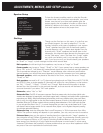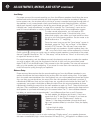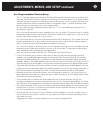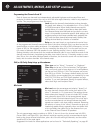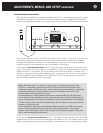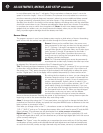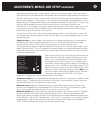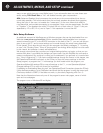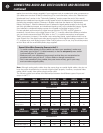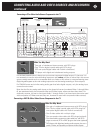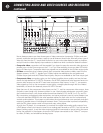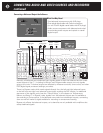
Trigger Setup
Many home theater components (including amplifiers, retractable screens, and some lighting
equipment) can be controlled by DC trigger signals. The C 1 has three trigger outputs, two of
which, P1 and P2, are programmable through this setup screen:
Trigger sense defines the event or condition that you wish
the C 1 to sense in order to generate a trigger voltage. A
few examples are: the moment when the C 1 is turned on;
activation of its display dimmer; the presence of a compos-
ite video signal, an S-video signal, or whichever comes first;
a change of video source (except component video) or any
audio source, or selection of any specific source (including
the 7.1-channel input and whichever source is assigned to
the balanced input).
Polarity does not change the trigger jack’s + output to – and vice versa, as its name implies.
Rather, it selects whether the individual trigger output is normally off or normally on. When
Polarity is set to “Posit.” the triggering event you selected will switch the trigger output from
0 to +12 volts; when set to “Negat.,” the triggering event switches the trigger output from
+12 to 0 volts. Each trigger output can deliver up to 200 milliamperes (200 mA) of current.
Delay adjusts the delay between a triggering event and the actual trigger signal output. It
can be set for “No” delay or for any of 14 delays, of 1 second to 3 minutes.
Duration controls the trigger signal’s duration. The trigger signal can be set to remain active as
long as the triggering condition applies (“Infin.”) or to any of 16 periods from 10 milliseconds
to 3 minutes. If duration is set to 10 ms or 100 ms, additional pulses of 10 ms and 100 ms are
generated when the triggering event ends. This enables the C 1 to control devices that require
separate turn-on and turn-off pulses.
The third trigger, marked “On-Off” on the rear panel, only operates when the C 1 is turned on
and off. It is set for positive polarity, no delay, and “infinite” (continuous) duration.
Thanks to the flexibility of its three triggers, the C 1 can initiate and end a number of operations.
For example: the “On-Off” trigger could be used to turn power amplifiers on and off with the C 1;
video-based settings could be used to lower a projection screen, turn on a video projector, dim
room lights, and draw window curtains.
THX Audio Setup
THX EX enable can be set to Auto or Manual. With Auto,
the C 1 will automatically switch into THX Surround EX
mode if the following conditions are met:
1. THX processing is switched on;
2.You are playing a Dolby Digital soundtrack that carries
the digital “flag” that identifies it as carrying information
for surround back speakers;
3.You selected Back speakers in “Speaker Setup/Size.”
If there is no EX flag, THX processing will default to THX
Cinema for 5.1- and 6.1-channel speaker setups and THX Ultra2 Cinema for 7.1-channel setups. If
“THX EX enable” is set to “Manual,” EX processing can be activated, when applicable, by press-
ing the THX key on the Master remote once or twice when the C 1 is in Direct mode.
Boundary gain comp. (compensation) tames the excessive, boomy bass that can occur when
listeners are near the back wall of home theaters whose subwoofers meet THX Ultra2 stan-
dards or have flat anechoic response down to 20 Hz. If you have such a subwoofer, setting THX
Ultra2 Sub to “Ye s ” gives you the option of turning this feature on or off (try listening to it both
THX Audio setup
THX EX Enable Automatic
Boundary gain comp.
THX Ultra2 Sub Yes
Boundary gain comp. On
ASA
Back speakers Together
Exit
Trigger setup
᭤ Trigger 1 sense PowerOn
-polarity Posit.
-delay No
-duration Infin.
Trigger 2 sense Vidsign
-polarity Negat.
-delay 15s
-duration 45s
Exit
ADJUSTMENTS, MENUS, AND SETUP continued
35



